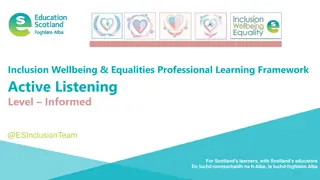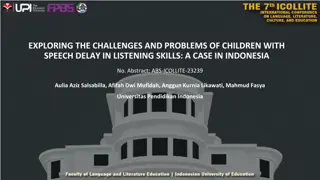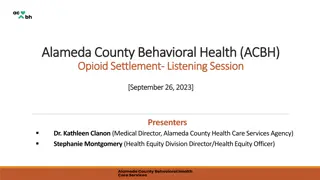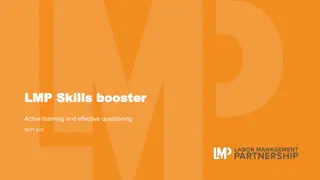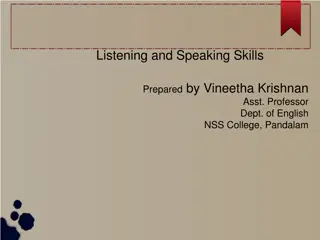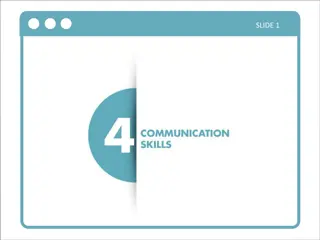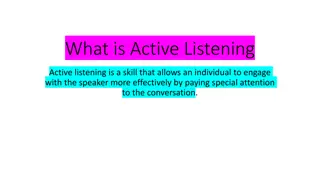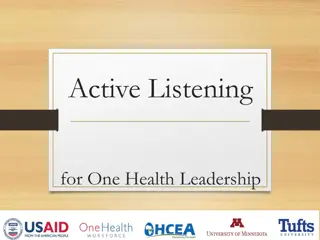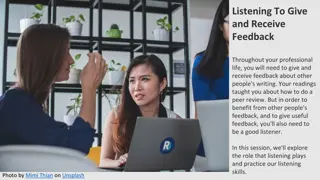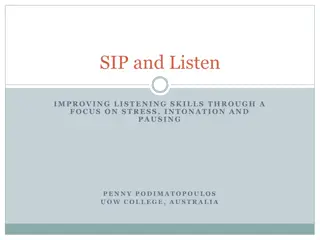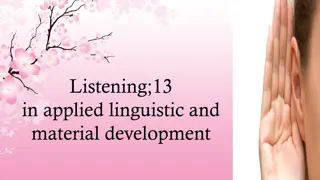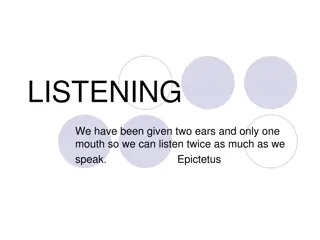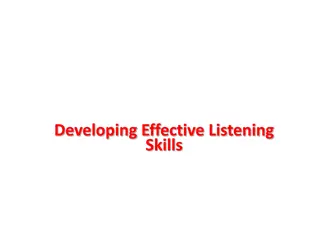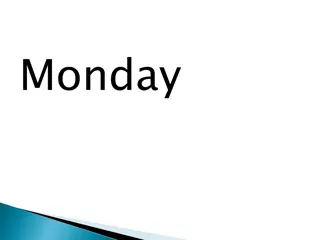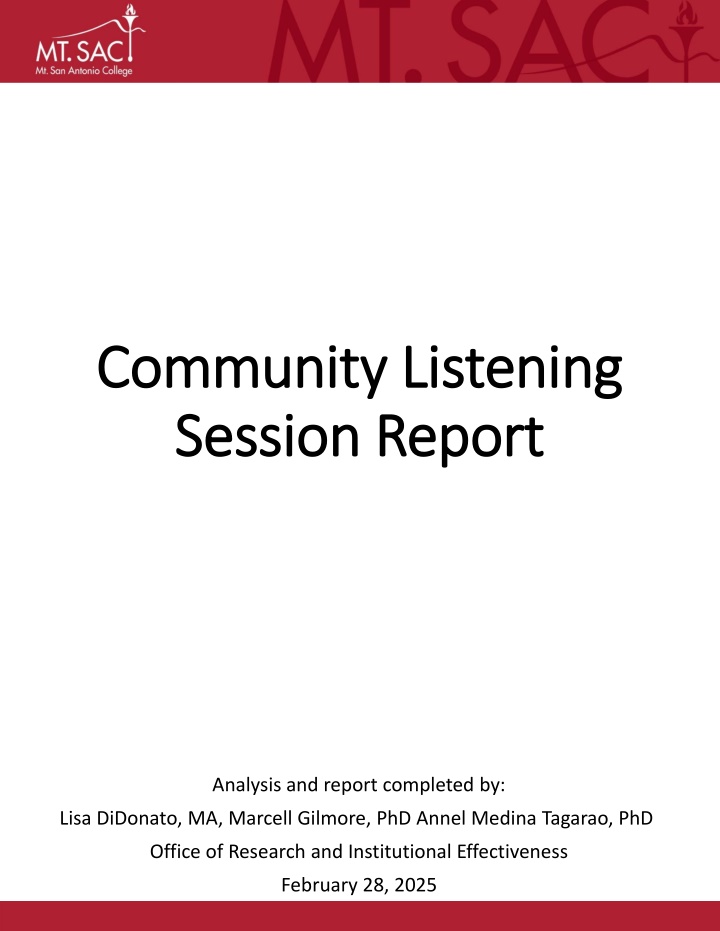
Community Listening Session Report: Insights and Analysis 2025
Discover the outcomes of completed community listening sessions conducted by Lisa DiDonato, MA, Marcell Gilmore, PhD, and Annel Medina Tagarao, PhD. Gain insights into what is working well, areas for improvement, and how these findings are shaping the educational landscape at Mt. SAC. Delve into the guiding framework, data collection methods, analysis processes, and feedback from educational and workforce partners.
Download Presentation

Please find below an Image/Link to download the presentation.
The content on the website is provided AS IS for your information and personal use only. It may not be sold, licensed, or shared on other websites without obtaining consent from the author. If you encounter any issues during the download, it is possible that the publisher has removed the file from their server.
You are allowed to download the files provided on this website for personal or commercial use, subject to the condition that they are used lawfully. All files are the property of their respective owners.
The content on the website is provided AS IS for your information and personal use only. It may not be sold, licensed, or shared on other websites without obtaining consent from the author.
E N D
Presentation Transcript
Community Listening Community Listening Session Report Session Report Analysis and report completed by: Lisa DiDonato, MA, Marcell Gilmore, PhD Annel Medina Tagarao, PhD Office of Research and Institutional Effectiveness February 28, 2025
Table of Contents Table of Contents Community Listening Session Report Table of Contents Completed Sessions Mt SAC 2035 Guiding Framework Data Collection and Analysis Educational Partners 1. What is Working Well? 2. What Needs Improvement? 3. How Do We Know? Parents 1. What is Working Well? 2. What Needs Improvement? 3. How Do We Know? Workforce Partners 1. What is Working Well? 2. What Needs Improvement? 3. How Do We Know Conclusion Appendix Appendix A Protocol Educational Partners Appendix B Parents Protocol Appendix C Protocol Workforce Partners 1 2 3 4 5 6 7 8 10 11 12 13 14 15 16 17 19 20 22 23 24 25
Completed Sessions Completed Sessions 3 completed sessions By modality: 2 in-person sessions 1 virtual sessions via Zoom Number of participants: 7 Educational Partners, 6 Parents, 6 Workforce Partners Total Participants 19 2/3/25 to 2/7/25 3
Mt SAC 2035 Guiding Framework Mt SAC 2035 Guiding Framework Equity means Mt. SAC provides every student with an experience that gives them the conditions to develop their full academic and social potential. Equity-minded planning seeks to eliminate institutional policies, embedded practices, and systemic barriers that have enabled inequity to exist and persist at Mt. SAC. Healing-centered planning recognizes the assets of students from disproportionately impacted groups and prioritizes their success in institutional goal-setting and decision-making at Mt. SAC. 4
Data Collection and Analysis Data Collection and Analysis Data Collection Listening sessions were audio recorded and transcribed verbatim. Recordings were transcribed using automated transcription software and then reviewed for accuracy. Participants were assigned pseudonyms in the transcripts to ensure anonymity. Data Analysis Data analysis was completed through thematic coding. In preparation of the report, the researchers developed a guide to frame the final analysis. 5
Educational Partners Educational Partners
1. What is Working Well? 1. What is Working Well? High School Outreach, Financial Aid, and Mt. SAC's Noncredit programs that assist in credit recovery and grade improvement were cited as exceptional programs that are doing great work. Allowing students to take college credits through dual enrollment or special admission is both a financial benefit as well as a time saver for students and their families. These services allow students to see that college is a viable option. That's my number one program that you guys have because our 9th graders and 10th graders, we don't have room for them for credit recovery." "I think that the outreach is great and very proactive with scheduling...we have sessions just for special education students, so it's a smaller environment...every time I've asked for something, they pretty much say, okay, let's work that out...we use the high school referral program a lot, and they're really great as well with giving us feedback...I think it's not only to get students enrolled at Mt SAC, but it's also to get them through high school." 7 Educational Partners
2. What Needs Improvement? 2. What Needs Improvement? The educational partners suggested outreach efforts and Mt. SAC services should begin earlier than 12th grade. Increasing parent participation through more interaction and multiple languages is needed. Offering career exploration via job shadowing, class audits, and more exposure to our trade certificates were additional areas for improvement. Concerns were voiced about students being lost in such a large institution and knowing where to get help. Preparing students for college in collaborative with our K-12 partners is also needed. "We bring the kids,... but the parents aren't super involved...the only thing is really financial aid that they're invited to cash for college... If the parent, not only the students can see the campus, but if the parents could see it as well, that would help." "Mt SAC is such a huge institution and there's so much here as the biggest college... that's great that there's all these offerings and programs, but I think a student can very easily get lost in that if they're not actively trying to be connected." 8 Educational Partners
2. What Needs Improvement? (Cont.) 2. What Needs Improvement? (Cont.) "I didn't know about the noncredit career tech programs until this last conference, and I went with counselors who were more experienced, and they didn't know either. And then we didn't know that they can transfer into for credit programs. So I think that that needs to be pushed a little bit more." "I think there should be a video that... carries students on for that application process...for dual enrollment when they're there, it's one-on- one. They re helping the students. But for the application on their own, they don't understand. Some of them are our ELD students and they don't understand the questions You know, and so if there's a video, there's that can be tailored to our students, so that they can answer each question correctly." 9 Educational Partners
3. How Do We Know? 3. How Do We Know? Data regarding their students' performance on success, retention, transfer, degree completion, and career data would indicate success. Some were aware that much of that data is in our Connect 4 dashboards. The achievement gaps among students and adopting a casework approach for students they identify as high risk were some ideas they thought could help. "I feel like that dashboard gives you at least some data on that. "As a principal, you're choosing us. I'm in charge of your education. You have to be ready for whatever's next... I think the transfer data and the persistence data really matters." 10 Educational Partners
Parents Parents
1. What is Working Well? 1. What is Working Well? Mt. SAC's assistance with college applications and financial aid was praised by parents. They highlighted the positive interactions with staff and the encouraging support from school counselors and teachers, especially for first-generation college students entering higher education. "What we have seen is the help that they have provided more than anything to him. To fill out the applications and all the kindness that has helped him. "Well, he is very excited, because his art teacher attended Mt. SAC, and he highly recommended it to him. And he is very excited. Parents 12
2. What Needs Improvement? 2. What Needs Improvement? Parents expressed the need for clear communication about logistics, credits, college pathways, and financial aid. There is a need for tailored guidance for students with varying academic goals. High school and college counselors were suggested as key resources to help students navigate their educational paths effectively. "My daughter wants to take, Radiology. But I still don't know how long that is. First, it has to take 2 years. "I also went to Mt. SAC to look for the Financial Aid Office. It was a little difficult for me...I arrived at the office, but they told me that they didn't speak Spanish. We'll go to Mt. SAC, but we don't know exactly how to do the enrollment and how to do the application because here everything is new for us. "So that's where I think more information for the parents from the high schools that are offering dual enrollment programs would be great. Whether it's coming from the high school or from Mt. SAC directly. Parents 13
3. How Do We Know? 3. How Do We Know? Parents highlighted the importance of ensuring students achieve their academic goals, complete their studies, and earn a degree. "Make sure the kids met their goals and finished their studies and graduated and earned a degree. Customizing a program for the student based on their goals upfront from the start. But for those that already know, have it mapped out for them and help them through each course. Parents 14
Workforce Partners Workforce Partners
1. 1. What is Working Well? What is Working Well? Workforce partners highlighted various personal and professional relationships they have with people and programs on campus that centered on data sharing, community improvement, and program connection. Cal Poly and Mt. SAC are very lucky to have presidents who talk and establish that relationship.. So, being able to reciprocate data is really huge. That's a big step between the two institutions. The Chamber, Mt. SAC and Cal Poly partnered for 100 scholarships. So why are we doing this? Because our mission is to improve the quality of life in our community. "As a parent and member of the community, my son came to Mt. SAC for the Disability Resource Center. They were phenomenal. Absolutely phenomenal." Workforce Partners 16
2. What Needs Improvement? 2. What Needs Improvement? During the listening session workforce partners expressed interest in Mt. SAC serving as a conduit between K-12 and employers. Reaching students earlier in the career and education decisions making process. If you partner with the K-12s and find out what their needs are, we have a way to move kids forward. And at some point when their interests and their desires and their needs are manifested. I'm hearing there's all these tentacles out there, right? And one thing that has been alluded to but not really widely discussed is K-12. So, here we are. So, Is post-secondary, but K-12 is kind of like the elephant in the room. Expose students to the interworking of businesses, which could be an inspiration (ah-ha moment). So, it gives them the idea that I don't just have to go there (Disneyland) to play. This could be used as a stepping-stone into a career through education. Workforce Partners 17
2. What Needs Improvement? (Cont.) 2. What Needs Improvement? (Cont.) The power that we have in higher ed is people. It is relationships. It's I don't call you because of your title; I call you because of your name. I know you and I have that connection, and that s why we re successful in what we do. And if we lose too much of that, we're screwed. We need to teach kids soft skills and because now they've lost it we need to teach that because anywhere you go, you need, you need those basic that basic knowledge of respect. Workforce Partners 18
3. How Do We Know 3. How Do We Know Key indicators that would demonstrate a successful partnership between Mt. SAC and workforce partners center on intentionality and symbiotic action. I would offer that instead of focusing just on one type of student. Have a couple of profiles student profiles because again, our needs vary Have different profiles of different types of students because they have different needs, and they're going to need different types of support. "When that kid realizes, Oh, I belong here. And that's the type of opportunity that Mt. SAC can provide to these kids to take them as take them in their raw form. And make them believe you belong. Here, you can flourish here with our support. It takes a sustained effort, It takes a written plan. It takes a team. That's the reason why I'm kind of excited by the whole notion of developing a plan and putting the right champions in place to advocate for those particular tribes, so to speak. Whether it's kids in I.T., kids who need support in finance, or kids who are at risk or at promise. I like that as a better phrase then we can make sure that this thing is going to actually be something that will sustain over a period of time. Workforce Partners 19
Conclusion Conclusion Four themes emerged from the three listening sessions. Communication In each listening session, better communication between Mt. SAC and the various stakeholders was an area for improvement. Providing clear and essential information about important topics like Dual Enrollment, financial aid, and community resources are sorely needed. Career and College Counseling The listening session participants suggested greater career exploration is needed. This should not be limited to pathways that require 4-year degrees but also careers that are possible through certificates. Students should leave high school with a career plan that allows them the transition to postsecondary or the workforce that has been vetted by educators and family. 20
Conclusion (Cont.) Conclusion (Cont.) Connecting Early The educational partners, the parents, and the workforce partners encouraged connecting with students earlier than 10th or 12th grade. In fact, some mentioned starting the career conversation prior to entering high school. Doing so would provide a deeper meaning and learning in high school and beyond. Collaboration Working collaboratively was another common theme from the listening sessions. Alone and siloed has led to limited success for students, families, schools, communities, and the workforce. Developing an intentional and symbiotic relationship that is grounded in realizing the potential of our students is fundamental to personal and community growth. In the end, stakeholders were looking for Mt. SAC to serve as a conduit that could connect students and families to educational and economic resources in the community. Providing the necessary support to educational and workforce partners to positively impact students. 21
Appendix Appendix
Appendix A Appendix A Educational Partners Protocol Educational Partners Protocol 1. How long have you been partnering/working with Mt. SAC? 2. During the partnership, what do you think has worked well? 3. What do you think could use improvement? 4. There are a few specific areas we would like to know more about. a) How can we better assist your students in transitioning to Mt. SAC? b) How can we better prepare your students to be college-or career ready? c) Are there resources we should be offering to better support student's educational journey? 5. Do you think Mt. SAC is a good choice for your students? Why? 6. What evidence would demonstrate Mt. SAC has a successful partnership with your institution? 7. Any other thoughts or comments about working with Mt. SAC? Conclusion: Thank you for sharing your comments.
Appendix B Appendix B Parents Protocol Parents Protocol 1. How is your student connected to Mt. SAC? 2. What do you like about your student s experience at Mt. SAC so far? 3. What would you change about your student s experience at Mt. SAC? 4. Does your student want to go to a two-year college for a degree or certificate or are they interested in earning a 4-year degree at a university? 5. What are some of the things you hope your student will gain from Mt. SAC? 6. Do you think your student will want to attend Mt. SAC when they finish high school? (Why-Why not?) 7. What should be our top priorities when working with high school students? 8. What evidence would demonstrate Mt. SAC has successfully supported your child s educational journey? 9. Do you have any other thoughts or comments about Mt. SAC's role in educating your students?
Appendix C Appendix C Workforce Partners Protocol Workforce Partners Protocol 1. How long have you been partnering/working with Mt. SAC? 2. During the partnership, what do you think has worked well? 3. What do you think could use improvement? 4. There are a few specific areas we would like to know more about. a) How can we better prepare students to work in your industry? b) What specific skills could we teach that are currently not taught? c) What resources should invest in to ensure our students are adequately prepared for your industry? 5. What evidence would demonstrate Mt. SAC has a successful partnership with your institution? 6. Do you have any other thoughts or comments about working with Mt. SAC? Conclusion: Thank you for sharing your experiences and perspectives!

